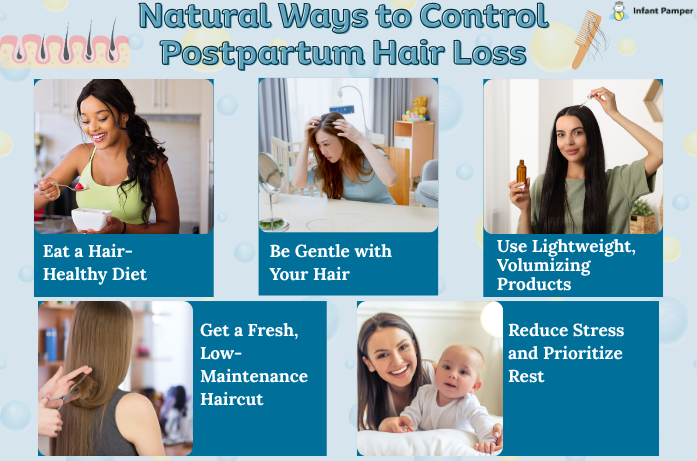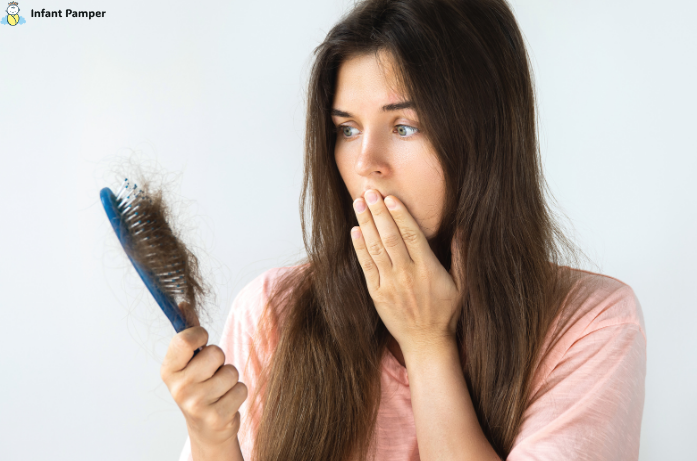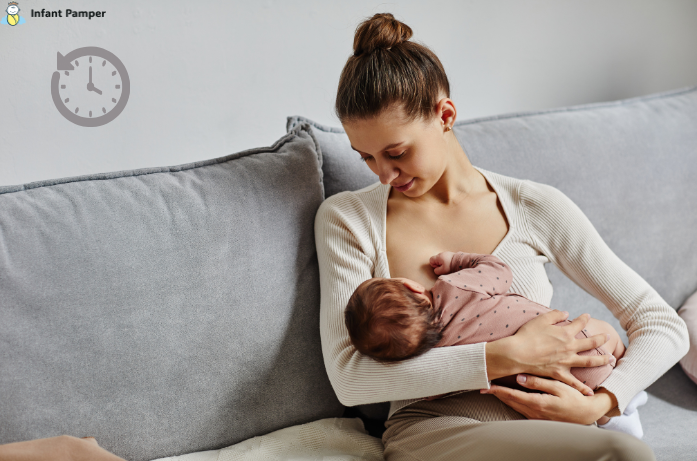By a Caring Mom at Infant Pamper
Women face many problems after childbirth. If you noticed more hair on your hairbrush, in the shower, or on your pillow, you are not alone. This sudden hair loss may surprise you and perhaps even frighten you, but it’s all part of the postpartum healing process.
After childbirth, a woman’s hormonal balance changes drastically, and one result is hair loss. Fortunately, postpartum hair loss is reversible, and in most cases, hair regrows on its own within a few months.
In this guide, we’ll discuss the causes of postpartum hair loss, how long it lasts, and the most effective ways to control and reduce hair loss after pregnancy so you can feel strong and supported during this time.
What Is Postpartum Hair Loss?
Postpartum hair loss, also known as telogen effluvium, is the condition characterized by sudden and extensive shedding of hair that many women experience after giving birth. Normally, it starts between 2 and 4 months post-delivery and lasts for several months.
The underlying cause of this is the big change in hormones after pregnancy, mainly the dramatic decrease in estrogen levels.
Why Does Hair Fall Out After Having a Baby?
To get the whole picture of postpartum hair loss, it is really necessary to get a good grasp of the normal hair growth cycle. The hair cycle consists of three natural stages:
- Anagen (Growth phase): Active hair growth happens at this stage, which may last for 2 to 6 years.
- Catagen (Transition phase): A brief period when hair stops growing and prepares to be shed.
- Telogen (Shedding phase): A period where hair is resting and old hair falls out for the new one to grow.
During the pregnancy, your body’s high levels of estrogen keep most of the hair in the growing phase which contributes to a fuller and thicker appearance of the hair. But, following childbirth, estrogen levels go down quickly, and a lot of hair is shifted into the shedding phase simultaneously.
The Johns Hopkins Medicine explains that the raised estrogen levels during pregnancy keep more hair in the growth phase (anagen), and when estrogen drops after birth many follicles shift into the resting phase (telogen).
How Long Does Postpartum Hair Loss Last?
Postpartum shedding is a typical cycle for most women that starts approximately 8 to 12 weeks post-delivery with the shedding of hair hitting its highest point in the 3rd or 4th month. The amount lost can be quite shocking, but no need to worry, it’s only temporary.
Most mothers usually witness their hair growth getting back to normal when their child reaches 9 to 12 months old. New short hair might also start appearing at the removed hairline or around the crown.
Is Hair Loss After Pregnancy Normal?
It is a very common occurrence. About half of new mothers are reported to have suffering hair loss during postpartum according to clinical trials.
The results of hair loss can be different for each individual. A few mothers go through just a slight thinning while others have the feeling that they are losing the entire head of hair. However, one should not be afraid, this is a natural process of healing after childbirth.
Signs of Postpartum Hair Shedding
- Hair visibly on your pillow or comb
- Increased hair loss during washing or brushing
- Ponytails looking thinner, or bald patches appearing on the hairline
- Hair strands on your clothes or those of the baby’s
In case of extremely high hair loss, prolonged hair loss beyond one year, or the presence of bald spots, it is recommended you consult your doctor to rule out other conditions such as thyroid malfunction or iron deficiency as the cause.

Natural Ways to Control Postpartum Hair Loss
It is impossible to completely prevent shedding during postpartum hair loss. However, one can use right hair care and lifestyle habits to manage it well.
1. Eat a Hair-Healthy Diet
To assist your body in rebuilding strong and healthy hair, proper nutrition is necessary. Try to consume foods that are abundant in vitamins and minerals that will nourish hair growth from the inside.
- Iron-rich foods such as spinach, lentils, red meat should be included in your diet.
- Protein sources such as egg, beans, lean chicken should be eaten.
- Include healthy fats like nuts, avocados, and fish like salmon in your diet.
- Continue taking prenatal vitamins if you are breastfeeding.
2. Be Gentle with Your Hair
Hair becomes very fragile due to childbirth, so treat it gently to avoid breaking and stressing the roots.
- Use a wide-tooth comb on wet hair rather than a brush
- Tight hairstyles such as ponytails and braids are not good for hair, so avoid them
- The use of heat styling tools like straighteners and dryers should be limited
3. Use Lightweight, Volumizing Products
The proper hair products can dramatically enhance the look and feel of your hair. Opt for the formulas that add volume without making your hair heavy.
- Volumizing shampoos and conditioners should be your first step
- Avoid heavy serums or greasy hair oils
- Look for products labeled “thickening” or “strengthening”
4. Get a Fresh, Low-Maintenance Haircut
A new haircut can boost your mood and your roots. Shorter or layered cuts make your hair look more voluminous and save time.
- Choose a style that adds volume and movement
- Keep your hair ends healthy by getting regular trims
- Avoid harsh chemical treatments during this phase
5. Reduce Stress and Prioritize Rest
Hair loss can be aggravated by stress and fatigue. So, think of yourself as a top priority, the same way you do with your baby.
- Go for a walk or do yoga or stretches
- Use meditation and deep breathing as part of your relaxing routine
- Sleep when your baby sleeps to help your body recover
Is There a Treatment for Postpartum Hair Loss?
In most situations, postpartum hair loss doesn’t need any medical treatment. However, if shedding continues for more than 12 months, or if there are other symptoms such as fatigue or weight gain, the doctor might recommend:
- Blood tests (for thyroid problems or anemia)
- Treatments like minoxidil (not always recommended for breastfeeding mothers, always ask first)
- Nutritional supplements, in case of a deficiency
Can Postpartum Hair Loss Affect Your Baby?
Postpartum hair loss is not harmful to the baby; however, if the fallen hair is wrapped tightly around the baby’s finger, toe, or genitals, it can be very dangerous. This is a rare case, known as hair tourniquet, which can lead to the cutting off of blood flow.
Check your little one frequently, especially if he or she is crying for no apparent reason.
When to See a Doctor for Hair Loss After Pregnancy
You should consult a healthcare provider if:
- Your hair loss continues for more than 12 months
- Bald spots or circular areas of hair loss appear
- Your scalp is scratchy, red, or inflamed
- You have other symptoms like tiredness, mood changes, or brittle nails
These might indicate thyroid disease or iron deficiency anemia, which can be serious health issues.
Final Thoughts from Infant Pamper
Postpartum hair loss can feel frustrating, especially when you’re already adjusting to the demands of life with a newborn. But remember, it’s a completely normal and temporary part of your body’s healing process after childbirth.
Be kind to yourself during this time. Focus on nourishing your body, getting rest when you can, and reminding yourself that you’re doing an incredible job. With a little patience and care, your hair will grow back and so will your confidence.
FAQs:
1. Will my hair grow back after postpartum hair loss?
The answer is yes, hair will revert to its normal state in 6 to 12 months after the delivery in most cases.
2. At what period I might see newly grown hair?
Very fine “baby hairs” close to your forehead or the peak of your scalp may be noticed around 3-6 months after the delivery.
3. Will my hair be the same as before pregnancy?
Color and length may remain the same; only difference is that it will be a little bit coarser or weaker in density and that a lot of moms eventually get their original volume back.
4. How long postpartum does it take for hair to become fully back again?
Generally, it takes the hair of the kid to get back to its pre-pregnancy condition by the time the baby is one year old.
5. Can I speed up postpartum hair regrowth?
A healthy diet, and less hair breakage due to gentle hair care and stress will underpin regrowth; but patience is the primary factor.
Medical Disclaimer: This article is intended for informational purposes only and should not be considered a substitute for professional medical advice. Always consult a healthcare provider for guidance on any medical concerns.
Every mom’s journey is unique, did you experience postpartum hair loss?
Share your story or tips in the comments below and help another new mom feel less alone.
Explore more Mom Care & Wellness articles on Infant Pamper




